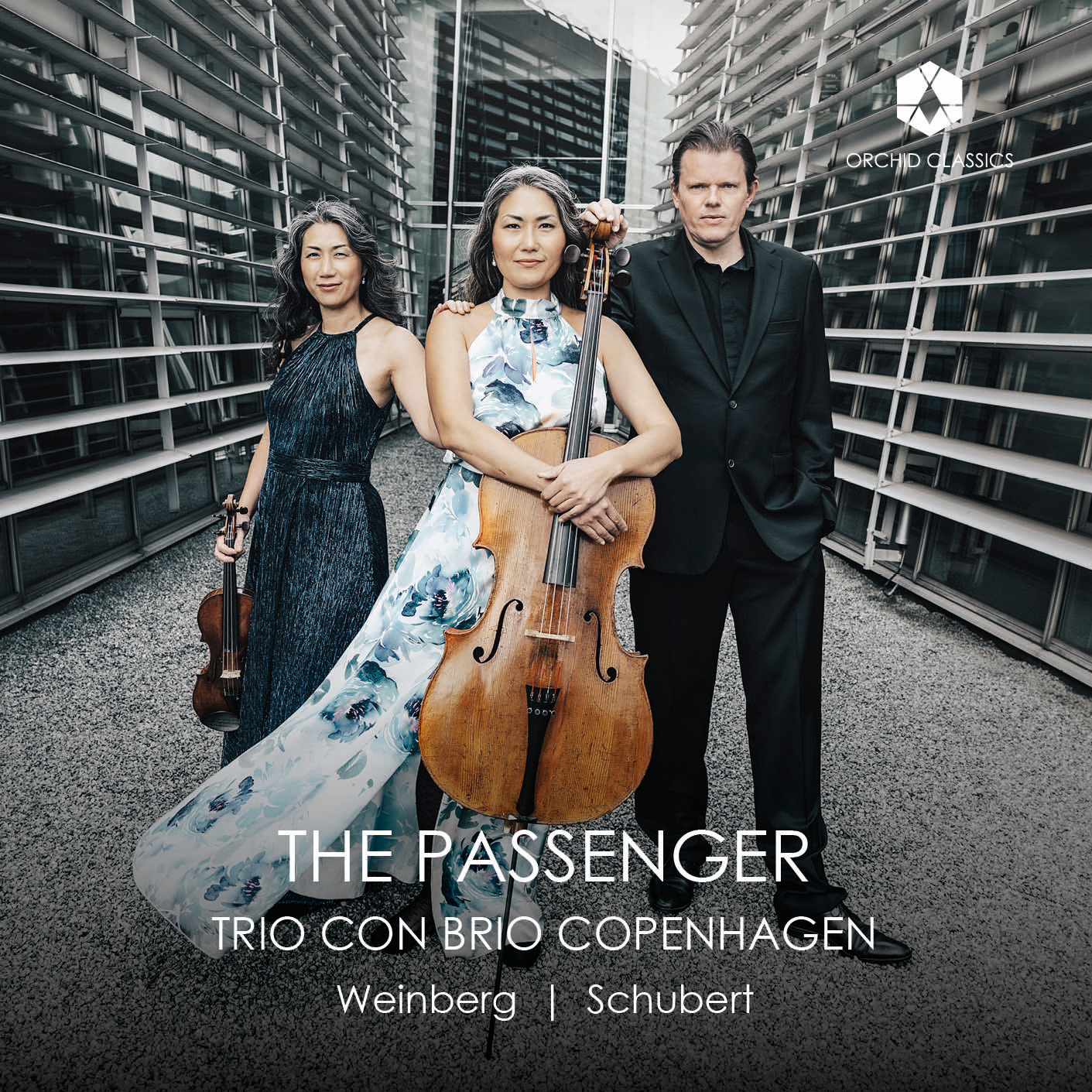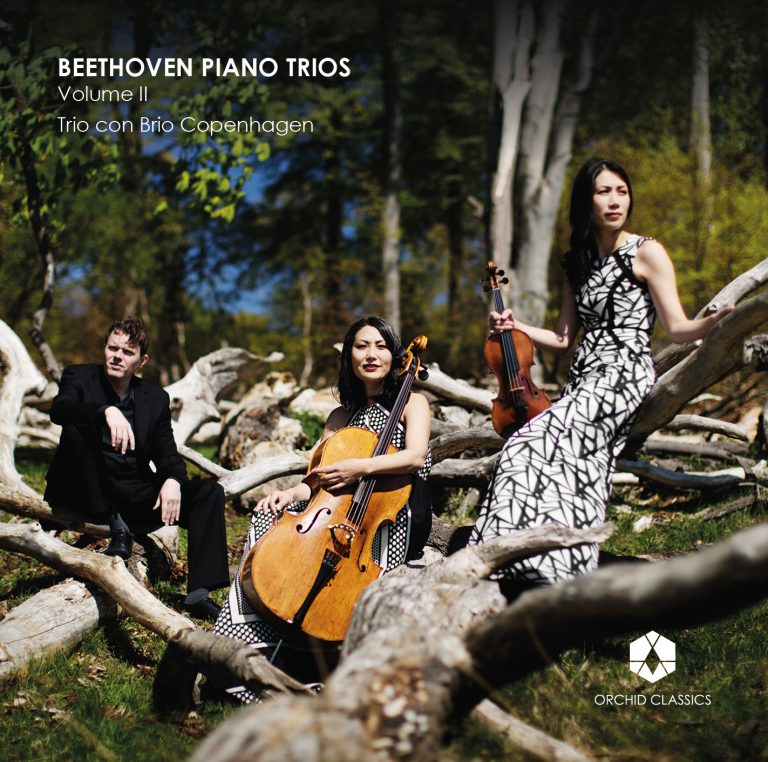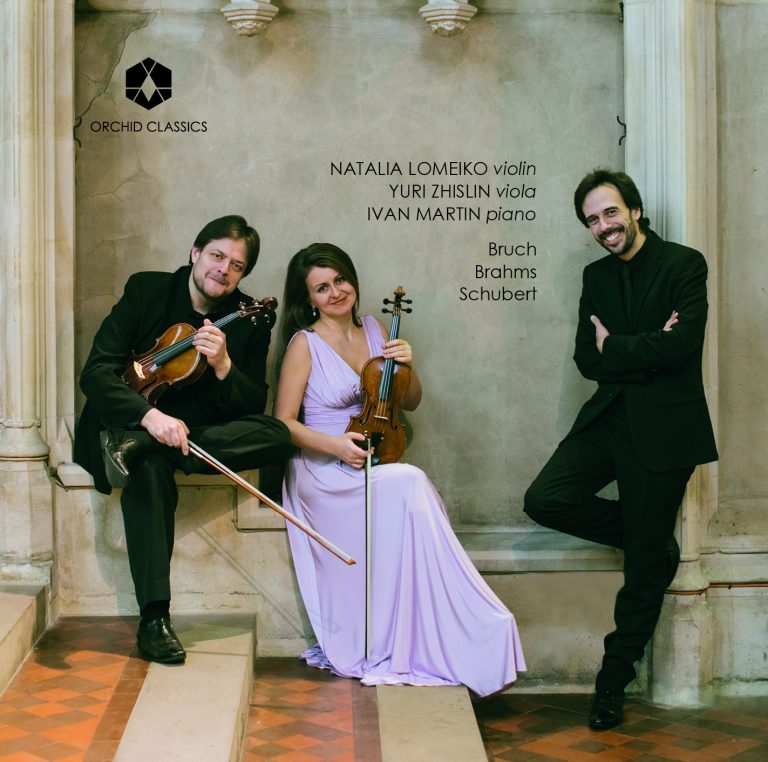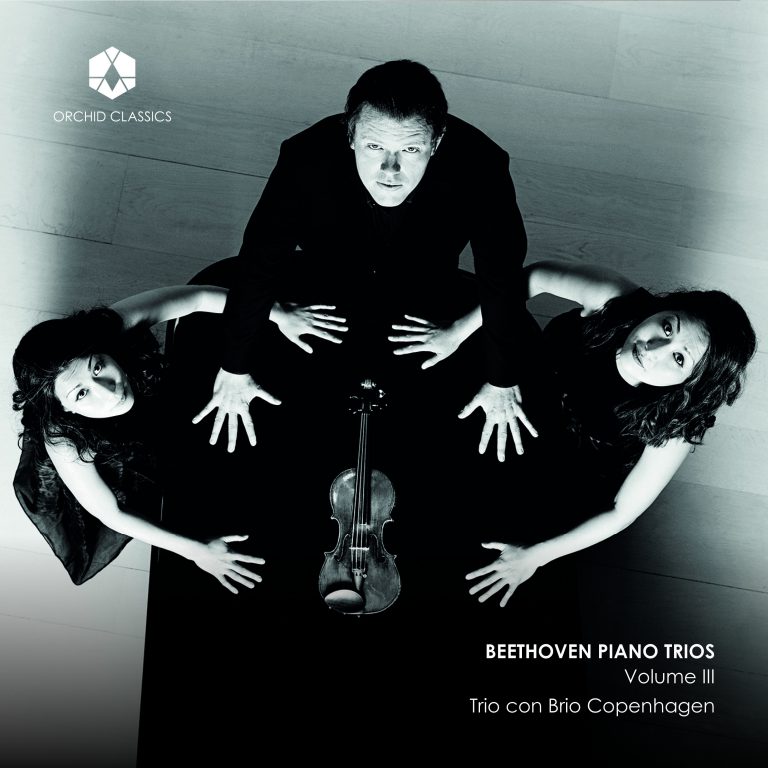Artist Led, Creatively Driven

THE PASSENGER
Trio con Brio Copenhagen
Release Date: 2nd Feb
ORC100282
THE PASSENGER
Mieczysław Weinberg (1919-1996)
Piano Trio in A minor, Op.24
1. I Prelude and Aria. Larghetto
2. II Toccata. Allegro
3. III Poem. Moderato
4. IV Finale. Allegro moderato
Franz Schubert (1797-1828)
Piano Trio No. 2 in E-flat major, Op.100 D.929
5. I Allegro
6. II Andante con moto
7. III Scherzo. Allegro moderato
8. IV Allegro moderato
Trio con Brio Copenhagen
Soo-Jin Hong, violin
Soo-Kyung Hong, cello
Jens Elvekjaer, piano
Mieczysław Weinberg was only 25 years old when he composed his Piano Trio Op.24, and Franz Schubert was 30 when he wrote his Piano Trio No.2. Despite the fact that both composers were young, it is as if death is present in the music. This is most evident in Weinberg’s trio, which was composed in Moscow in 1945.
As a Polish Jew, Weinberg fled eastwards when the Nazis invaded Warsaw. It was at the last moment. Mieczysław Weinberg was the only one in his family to survive the Second World War. All four movements of the trio are characterised by unrest and despair. There are traces of klezmer music and the finale concludes with a gentle, tuneful waltz before the last notes die away. This waltz foreshadows Weinberg’s main work, the opera The Passenger from 1968, where it is precisely a waltz that links evil in a concentration camp to a future in which all are victims.
In Schubert’s Piano Trio No.2, written one year before Schubert’s early death in autumn 1828, the Swedish folk song Se solen sjunker (See the sun is setting) plays a key role. Schubert began work on the trio shortly after he had heard the song in Vienna, which is about the sun sinking behind the mountain peaks, while all hope is chased away by night’s shadows. And clearly the song made a strong impression on him, for the funeral march of the second movement, based on Se Solen sjunker, is the emotional climax of the trio.
Introduced by the cello, the Swedish folk song in Schubert’s instrumentation is like a statement about human loneliness and great sadness, mixed with elegance and marvellous beauty. All these qualities which the film director Stanley Kubrick further develops in his incomparable film Barry Lyndon, in which precisely this music is the musical thread of the narrative of the nobleman Barry Lyndon, who experiences a spectacular human and social déroute.
Although Mieczysław Weinberg and Franz Schubert lived in vastly different worlds, there is nevertheless a great deal that links them together. Via the music in the two trios, they make us painfully aware of the fact that life is fragile and only something we have on loan. It should be noted, they do so with music which, at the crucial moments – such as Weinberg’s waltz in an otherwise despondent conclusion, and Schubert’s musical staging of Se solen sjunker – praises beauty, making it appear as an attraction and a place of spiritual refuge. We are, though, dealing with a beauty which does not possess enough in its own euphony, and which the conductor Sergio Celibidache has described in the following opposite way:
“In der Musik geht es nicht darum, daß Sie Schönheit erfahren. Es geht um Wahrheit. Schönheit ist nur der Köder.”
“Music is not a question of your experiencing beauty. It is a question of truth. Beauty is only the bait.”
Mieczysław Weinberg
Trio for piano, violin and cello, Op.24 (1945)
The piano plays a main role in Weinberg’s Trio. Weinberg himself was an excellent pianist, and he also played the piano part together with the violinist and cellist from the Soviet elite ensemble, The Beethoven String Quartet, at the first performance in Moscow in January 1947. Three of the four movements start with a piano solo, and it is also the piano that is the driving force in the opening of the first movement Prelude and Aria.
With a theme in which all the notes are hammered out with considerable emphasis, it is obvious from the outset that this music is unstoppable once the playing has begun. And, with the strings stretched out in massive chords from top to bottom and played at full strength, the strings and piano form a common front with their respective effects. When the aria finally emerges in the lone singing violin and with the bass of the piano as a dully ticking clock of fate, we witness existential music of deep pain and a sense of the single individual.
The Toccata of the second movement starts as a wild piano ride that gradually drags in the strings in escalating music which, with uneven time signatures and Jewish references to the klezmer nightmare music, lashes the music up to a wall of death right up until the sudden conclusion in which the music descends into a black hole, is devoured and is destroyed.
Despite references to the Baroque, where the toccata is often virtuoso music characterised by great imaginativeness, Weinberg’s toccata is more closely related to the Romantic cultivation of the challenging of boundaries, and quite explicitly with Schubert’s lied Erlkönig, where a father rides out into the darkness and the night with his young son with such force that the boy finally dies in his father’s arms.
Poem, which continues without a break after Toccata, starts as a violently gesticulating improvisation for solo piano, where the music in repeated, violent movements pull one downwards to a kind of zero-point. From here, a new music emerges in a tuneful Adagio, with a painfully singing cello as the underlying force. This is a kind of song without words, which starting with a gentle major foundation laid by the piano and at times precisely measured by the violin’s pizzicato, slowly comes into its own and in dignified fashion gazes out over the horizon in a deserted musical landscape.
It is at moments like these that the connection with the slightly older Dmitri Shostakovich becomes evident. Weinberg got to know Shostakovich after fleeing from Poland, and they enjoyed a lifelong friendship. The two composers greatly respected each other, used to show each other their new compositions, and Shostakovich’s Piano Trio no. 2 from 1944, together with Weinberg’s Piano Trio from 1945 are a musical pair of twins that develop the piano trio as a genre and transform it into a human voice that include much of the horror being enacted in the Soviet Union in the years around the Second World War.
From that perspective, it is thought-provoking that Weinberg chooses the title Poem for one of the movement titles. He offers no indications as to what the music is about. But when the music, having passed through a number of dramatic phases, calms down, it is in a shaken musical world.
The violin part has admittedly sought heavenwards and the chords in the piano’s low register are friendly, bright major sounds. But the mood has become more sinister. We find ourselves in a parallel world that attempts to escape from reality.
The experience of fleeing is further developed in the Finale. The music insinuates itself into us, first in the form of a cryptically tiptoeing piano part and then a subduedly whispering violin part. The result is a breathless presence that becomes all the more intense when all the forces are unleashed in a great, powerful fugue in which the three voices chase each other, with once again hints of klezmer music in the musical gallop, and with the circle being completed by the return of the monumental opening theme from the first movement’s Prelude. From here there is no turning back.
The deliverance into no man’s land is found in the waltz mentioned earlier, which gently rocks us into gentle-sounding final music saturated in the gleam of transfiguration.
Franz Schubert
Trio for piano, violin and cello in E flat major, Op.100 (1827)
With the Piano Trio in E flat major, Schubert, at the end of his life, created a piano trio which surpassed everything that had previously been written within the genre, both as regard range and expressiveness. Unlike his contemporary Piano Trio in B flat major, which is lyrical and smiling, the E flat major trio is imposing and dramatic. The trio starts with a manifestation. The three instruments in unison proclaiming the key of E flat major with maximum concentration. At the same time, it is a motto and a greeting to Beethoven’s third symphony (Eroica) which, just over two decades previously, had established E flat major as the heroic key par excellence.
Shortly afterwards, however, the scene changes. That which seemed to be a display of outer magnificence and drive is suddenly replaced by a nervously repeated theme that, played pianissimo, appears to be an anxious tapping with bated breath. In the space of one minute, Schubert has shown himself to be a composer who embraces extremes and gazes deep down into the human mind, recognising loneliness as a basic condition.
The music surges back and forth in the long first movement, and although we are dealing with a drama that occasionally becomes so dense that everything goes black, the music does not fall apart. The singable is a part of Schubert’s musical DNA, and with a wealth of themes that stand in line one after the other – and with an underlying stream of simple musical figures that are repeated again and again – the music proves to be linked to a life-assertive forward impetus.
In the second movement, Andante con moto, the picture changes. With the fixed pulse of the funeral march in the piano, Se solen sjunker is played with great gravity. And the simple, lilting Swedish melody, sung with an emotive voice in the cello, is instinctively linked to something tragic. That which originally was conceived as an unpretentious song characterised by lightness, is now enclosed in a large form that reaches upwards towards much higher mountains than the Swedish ones and outwards towards infinity. After the music, which otherwise is couched in a gloomy C minor, has temporarily found itself in a gently rocking major zone, the two string instruments seek upwards and downwards for extremes, and the notes are hacked out in blocks on the piano, so that one can almost glimpse Anton Bruckner on the horizon.
A moment later, it is as if everything has been forgotten. The strings phrase with sweetness. The expression is enticing, intimate. So it seems all the more violent when Schubert suddenly pulls the carpet from under our feet and, in mid-movement, provokes a chaos of sounds, with a welter of repeated notes and violent dynamics that contains both ecstasy and hysteria. For the same reason, one can scarcely believe one’s ears when the mournful sunset melody suddenly shifts to the major in the piano, just before the movement ends. At the same time both a revelation and a warning that all hope is lost.
In the third movement, Scherzo, life returns. The notes flow as easily as water in the nature that Schubert loved. But, as if it was a filmic effect, there is a sudden clip in the music, and we are in the middle trio section, which is played with a militarily sharp edge. A warning of abysses in the midst of idyll.
The last movement, Allegro moderato, is both a joyous tribute to the uniting forces of music and a relaunching of some of the menacing elements in Schubert’s Piano Trio no. 2. With the dancing main theme, which has the character of a Ländler, we are from the outset in a cosy Austrian heartland. So much greater is the transformation therefore when the naïve folk dance is woven into a large musical form and later reappears in various strange musical manifestations. The contrasts can, however, quickly be counted, for the very next theme is in the minor, and with a minimalistic quite faint note Schubert introduces a music that is related to a song of the same period, Die Krähe (The Crow) from Winterreise. This is the song about the crow that follows the lonely wanderer. The crow, which is at the same time a friend and – the day the wanderer drops down dead – hacks away at his body.
The finale movement is a journey through various changing keys that colour the music in a rainbow of nuances and show the piano trio to be a medium that contains both orchestral greatness and expressive, intimate moments. And with the return of Se solen sjunker in the cello, surrounded by tender and passionate tones from the piano and violin, Schubert shows himself to be a master of emotion and fervour. And by constantly modulating the musical material towards the conclusion, a synthesis takes place. Just as at the beginning of the trio – expressed via the key of E flat major – we witness a celebration of music’s inherent force.
The music has en route shifted key signatures. Major and minor, large and small are united as part of a larger picture in which the experiencing of transformation is the crux of the matter. Existence is seen as an ongoing transit, in which beauty perhaps nevertheless plays a main role, despite all the horrors of existence.
Thereby, the journey through life to death which Mieczysław Weinberg expresses in his piano trio and in the opera The Passenger also has its natural place. In Schubert’s musical universe.
© Trio con Brio Copenhagen & Esben Tange
Trio con Brio Copenhagen
Acknowledged as one of the world’s finest piano trios, the Trio con Brio Copenhagen’s multifaceted members are not only performing artists who tour extensively, but also esteemed recording artists, artistic directors and educators. Founded at the University of Music and Performing Arts in Vienna in 1999, the trio is now based in Copenhagen and tours worldwide. The Trio was born out of an idea of the coming together of ‘musical pairs’ – of the two Korean-born sisters, Soo- Kyung Hong (cello) and Soo-Jin Hong (violin), with Soo-Kyung and her husband, Danish pianist Jens Elvekjaer.
They quickly gained a reputation for their fresh and contemporary approach to the core repertoire. “Works by Beethoven, Schubert and Brahms are transformed in their hands into the alive-and-kicking music of today” said Danish Broadcasting’s Esben Tange. Winning almost all of the major competitions for piano trio – including the ARD (Munich), Vittorio Gui (Florence), Trondheim Competition (Norway), Kalichstein-Laredo-Robinson International Trio Award (USA), Allianz Prize (Germany) and the prestigious “P2 Artists Prize” (Denmark) – they are regularly heard at the world’s leading venues and concert series. Among these, Carnegie Hall, Lincoln Center, Wigmore Hall, Berlin Pierre Boulez-Saal, Concertgebouw, Elbphilharmonie Hamburg, Seoul Arts Centre, Louvre Paris and of course their beloved “home venues”, DR Koncerthuset and the Tivoli Concert Hall, in Copenhagen.
Trio con Brio Copenhagen plays a central role in Scandinavia’s vibrant contemporary music scene. Leading composers have dedicated works to the Trio. They were enormously honoured that Per Nørgård dedicated to them a new piece celebrating his 80th birthday in 2012. In January 2016 the trio presented the world premiere of Bent Sørensen’s Triple Concerto with the Danish National Orchestra, a work that won the prestigious Grawemeyer Award. They premiered Sven-David Sandström’s Triple Concerto, a work that marks his 70th birthday.
The ensemble’s recordings have received tremendous critical acclaim. The latest album of Shostakovich and Arensky trios (Orchid Classics) was a Gramophone “Editor’s Choice” and singled out by BBC Music Magazine as a “Chamber Choice” of the month. The disc also won the German Record Critics’ Award (Preis der deutschen Schallplattenkritik). An album featuring the complete Beethoven piano trios (Orchid Classics) garnered broad, enthusiastic praise from critics and fans alike with the BBC Music Magazine calling it “a triumph.” The Trio has also recorded the work of leading Scandinavian composers, including Per Nørgård, Bent Sørensen and Sven-David Sandström, who have written works for the group.
Reviews are fulsome. “One of the greatest performances of chamber music I’ve ever encountered,” praised American Record Guide. Gramophone wrote, “Superb…Any group would be hard-pressed to imitate this blend of verve and poise…” Their Mendelssohn album was chosen by the UK’s Classic FM as the Best Chamber Music Disc of the year: “Every phrase soars and pulsates with the excitement of a fresh discovery as the Copenhagen players go the full distance with playing of skin-rippling sensitivity… sensational playing…”. Their Tchaikovsky and Smetana recording was hailed by The Guardian, “… Trio con Brio Copenhagen scale Tchaikovsky’s heights with the verve their name suggests …” The trio’s most recent recordings of the complete Beethoven piano trios were received with the highest critical acclaim, with comments such as “… I was struck… by the feeling of improvisation; of three players moving forward together into a strange and wonderful new world…” (Gramophone).
Trio con Brio Copenhagen serves as artistic directors of the annual festival, Chamber Music at Lundsgaard, and the Hellerup Chamber Music Society in Copenhagen.
Soo-Jin plays an Andrea Guarneri violin, Soo-Kyung plays a Grancino cello, and Jens is Denmark’s first Steinway Artist. Both string players are endorsed by Jargar Strings and Thomastik-Infeld Vienna. All three members of the trio knew right from the start that they would find their musical identities as a piano trio: “There is something about the configuration of a trio, about that triangle, that somehow focuses and amplifies the special understanding that we all have as people and as musicians. It is both a freedom and a fulfilment”.










